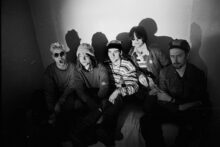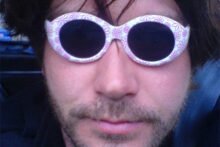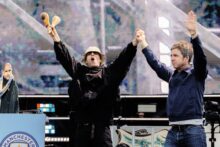In one of his essays – ‘The Argentine Writer And Tradition’ (1951) – Jorge Luis Borges wrote of the absence of camels in the Quran, suggesting it was a sign of the text’s authenticity. To a local of that time and place, the pack animal would have been so natural and ubiquitous as to be scarcely worth noticing or commenting upon. They would be taken for granted, and only an outsider would feel compelled to emphasise their presence. In reality, there are mentions of camels in the Quran, which Borges likely knew – ever the trickster, he delighted in unseating his reader and toying with the veracity of literary sources (in this case pinning the blame on Edward Gibbon via a misquoted quote). The spirit of his argument, though, has its truths. A case in point is the United Kingdom. Why would you need to name a nation that if it were true?
You don’t need to travel far to see evidence of other kingdoms within this one. It’s not even so much a case of fractures (though they do exist) so much as unique lands within the legal binding fiction of a state. The reasons are complex – cultural, demographic, industrial, topographical – but the differences and idiosyncrasies are self-evident when you spend time in places like the Fens, Cornwall and the Black Country. Usually, they are geographically isolated, jutting out into the sea, surrounded by moors or mountains. Places where the vernacular can, and has to, come from within. Fife is one such place. It even boasts that it is a kingdom or rather the kingdom. And within it, matryoshka-style, is a smaller kingdom still, on its furthest Eastern reaches on the shores of the North Sea – the East Neuk, one of our most isolated, unlikely and fertile musical hubs (see the discographies of King Creosote, James Yorkston, HMS Ginafore, the Pictish Trail and various Fence Records alumni).
It’s doubtful that there are any camels in Fife, let alone the East Neuk. And there is scarce mention of the landscape or folklore of the place in the lyrics of their finest sons, The Beta Band. No fishermen or hermit caves or nuclear bunkers, no derelict air strips or witch-hunted woods, no dismantled monasteries, World War II pill boxes, picturesque corbie-stepped seaside villages, or boulders launched at church spires by the devil. Yet the East Neuk soaked through everything they did. There’s a case to be made for a theory of the periphery – how musical innovators often come from relatively remote places (think of Eno coming from East Anglia, Aphex Twin from Cornwall). When you grow up in such a place, you’re disconnected from accessible mainstream culture in a way that forces you to make your own entertainment, to become creative or lose your mind through boredom, but also to prove that nowhere is really peripheral at all and everywhere is somewhere. It’s a curse and a gift. One lifeline is, or was when they existed, the record store – an umbilical cord to sustenance from elsewhere. Yet if you wanted live music, you have to make it yourself, which again is an inadvertent blessing, turning passive spectators into active participants. And if the results of mimicking tunes from far-flung cultures was inevitably botched, leading to mutant abominations, all the better. This was, after all, a kind of musical dialectic that pushed things in different directions.
Enter Champion Versions. Part of the enigmatic appeal of The Beta Band’s debut EP is that it appeared to come from nowhere. There’s very little on this tiger-emblazoned record to suggest initially who, where or what they were. Yet there are clues upon further inspection. On the Side A label there is a picture of a bird, a reference to their former incarnation as The Pigeons. On the back, a touching dedication: “Special thanks and love to Gordon, take the South road soon”, referring to Gordon Anderson – King Creosote’s brother – who’d grown up in the East Neuk with fellow founding members Steve Mason and John Maclean (drummer Robin Jones was picked up along the way at art school in Edinburgh). Anderson had co-written two of the tracks on the 12″ (‘Dry The Rain’ and ‘Dog’s Got A Bone’) and had headed to London with the band to sign with EMI but was forced to return to the East Neuk, surviving a lengthy and distressing period of mental illness, eventually producing a sprawling treasure trove of music under the name the Lone Pigeon and as a member of The Aliens.
The musical influences and origins of The Beta Band are hidden on the sleeve as well as the music therein. Dub was a guide – the sense of space and atmosphere, the forefront rhythm section, the experimentalism – with the EP taking its name and design from King Tubby (Presents The Roots Of Dub). This influence tended to hail from the sunnier, more buoyant and playful side of dub compared to the more claustrophobic strains that were influencing trip hop at the time, for example. There were mod influences from Mason’s scooter days, a self-taught punk daring, and a sense of outsider or art school adventurism in their style, with the sleeve illustration based on the found art of a packet of fireworks. Hand-made collage ran through much of their work to come (they would simultaneously publish their own Flower Press zine series) but also reflected their combinations of contradictory styles of music.
Two things held it all together. The first was a shared love of turntablism and through it sampling, scratching, loops, and the incorporation of electronics (this would blossom fully later on Hot Shots II). Few bands from these shores were as attuned to the radical production techniques that Timbaland, DJ Premier and RZA were developing at the time as The Beta Band. Their DJ sets were always gateways to music far beyond that of the conventional guitar band, and their influences tended to be outside any rockist lineage. They’d mock comparisons to even the weirder end of that spectrum – Meddle-era Floyd for instance. This wasn’t some kind of culture cringe or cooler than thou obscurantism so much as a continuation of the cargo cult necessity of being open to whatever washed up in the record store, whether it was tropicalia, honky tonk or Persian funk. Many of these strains would find their way into the band’s music in warped or subliminal form.
The second was folk, the music from their environment. Their unique take on this reflected a resistance as much as inspiration. What kept the music in check, from spilling into novelty wackiness or daisy age pastiche was a fathomless East Neukness. It would be pushing it to say that their use of acoustic music was in any recognisable sense trad. Yet there’s something in the shimmering fingerpicking, in the way the melodica hangs in the air like an accordion, in the dreamy vocals that captures that weird sadness when the haar rolls in from the sea and everything familiar turns surreal.
These qualities are easy to miss on the opening track, one of the finest of any band’s career, ‘Dry The Rain’. It starts with a stoned groove so laid back it’s almost sliding in reverse, with an accompanying country Beggar’s Banquet-esque dimestore slide guitar. It then builds and builds and builds to a triumphant fanfare-laden crescendo. Listen to the lyrics though, which can often sound (deceptively at times) like rhythmic place-fillers on Beta Band records, and a trend is set for much of their later work. It’s hilarious and characteristically self-deprecating; they didn’t call themselves the Alpha or Sigma Band after all. “This is the definition of my life / Lying in bed in the sunlight / Choking on the vitamin tablet / The doctor gave in the hope of saving me”. Openhearted romantic yearning view with desolation, solitude and self-disgust, “Walked in the corner of the room / Junkyard fool with eyes of gloom”. The crate-digging hip hop influence is present in the drums – a slowed down sample of a break from ‘Black Grass’, a funk/bluegrass curio by 70s band Bad Bascomb, which is accompanied, as the song moves up a gear, by a heavier drum loop from ‘Hi-Low’ by Curtis Knight. And dub is there too in the magnificent moment when the bass (played by soon-to-leave member Steve Duffield) surges forward and the brass let loose. The vulnerability of “Take me in and dry the rain” and “I need love” is meets an affirmation of strength and love, “If there’s something inside that you wanna say / Say it out loud, it’ll be okay / I will be your light”. It feels as miraculous as music gets.
The lo-fi shuffle of ‘I Know’ follows as if the band knew decompression was needed after the opening rise to the surface. The track has a dusty four-track intimacy, a kind of thumbnail sketch of more polished gems coming out that year on Mo’ Wax. It’s hard to describe what they’re doing, and the term applied to them at the time, folktronica, seems inadequate and constrictive for music where you didn’t know where it was going to go next. On this tune, there’s another hip hop indebted rhythm but, regardless of the instruments used, it sounds like a bizarre acoustic version of electronic music, like a schoolchild trying to build the internet during a woodwork lesson. It’s aged remarkable well, partly because it already sounded aged; the necessity of recording on a shoestring meaning they avoid the production slickness that has vacuum-packed so much then-cool music from the time. ‘B&A’ follows in a similar vein, though darker, heavier, and with more purpose. The simplicity of the structure (hence the title) allowing for the extended multi-instrumentalist interplanetary psych-funk improvisations they specialised in live. Even on the studio version, Mason ends sounding like a sorcerer howling through a storm. At a time when Britpop had de-evolved into faux-earnest invertebrate anthem-by-numbers by Travis or Coldplay, this felt heroically different and imaginative. Both tracks have a compelling mystery to them, a lostwave quality, like tunes you’d find, pre-Shazam, on a cassette somewhere with no labels. The EP comes in to land with the gorgeous pastoral ‘Dogs Got A Bone’, a faintly nautical folk tune stained with melancholy (“Can’t help this feeling, of feeling so alone”), somewhere between fellow Fifer King Creosote and Augustus Pablo. Towards the end of the song, it starts to expand, out of mellow quietude into something else entirely, something psychedelic and suggestive of things to come.
The general view of The Patty Patty Sound is that it’s the most experimental and trippy The Beta Band ever got. While there’s truth to this, conscious of their punk and hip hop influences, the band played down associations with hippy ergotism and any hint of prog. An alternative view is suggested by the title of the EP’s centrepiece track – ‘Monolith’. The second of The 3 EPs is the Fife Space Program version of 2001: A Space Odyssey, with its hallucinatory Stargate sequence and the group as both bone-wielding apes and adrift astronauts.
It’s obvious from the beginning of ‘Inner Meet Me’ that something is building to take off into the stratosphere. Gathering speed, it orbits in such a tranquilising way that you forget they’ve essentially made a trance record with acoustic guitars. ‘How’ is a word that surfaces often during the early audacity of their catalogue and the answer might be in simply not knowing any better. The song is also notable for a hilariously ridiculous and inspired accompanying video, with the band and assorted friends dressed as extraterrestrials ascending the Scottish mountain Stac Pollaidh backwards. Maclean has a Heath Robinson ingenuity for making inventive videos from no budget, and has gone on to prove his feature filmmaking talents with the excellent Slow West and this year’s Tornado. The music has that quality too, a kind of backyard alchemy, like tuning into an old episode of Blue Peter to find them building a nuclear reactor from stuff you can find under the kitchen sink.
Keeping the momentum going, ‘The House Song’ is dub-inflected dance music (hence the title) driven by bassist Richard Greentree, who was permanently onboard from this EP onwards. It drops into pidgin rap, a birdsong solo and, as with many of the more-groove less verse-chorus-based tunes, it served as an opportunity for expansion live as a clattering percussive jam closer to Can or Africa ‘70 than any Britpop act. Both the dance element and the vocal layering would be mastered on future B-side ‘Sequinsizer’ and it’s tempting to wonder what a full-length tangent into electronic dance might have become.
And so to ‘Monolith’, the kaleidoscopic heart of The 3 EPs. Somewhere between ‘Revolution No. 9’ and the KLF’s Chill Out (the latter beloved by the band), this lengthy odyssey never sounds the same twice. You’re always noticing more and different things. For all its musique concrète wanderings and feral children let loose on an orchestra élan, it remains memorable, even catchy, due to several encounters or viewpoints along the way – the speeded-up sample of the exotica track ‘Simba’ by Les Baxter, the glimpses of future track ‘Smiling’, the little rivulets of echoing guitar, and the nightmarish chopped-up industrial section. It may well be deep and meaningless, led on a wild goose chase by four individuals who regularly veered between wide-eyed idealism and eye-rolling belligerence, but ‘Monolith’ is still an enigma.
The EP ends with what for many fans is their supreme moment, ‘She’s The One’. Like ‘Inner Meet Me’, it’s another sublime example of spiralling hypnotist disk mind-bending. As with a lot of their songs, soulful admissions of fear, failure and heartache (“Falling through the floor with the friend I had before / Grabbing at straws so the holes don’t slow me down”) are hidden amidst nonsense lyrics. It grows into one of their trademark heavenly crescendos, even as they try to reduce lift by sucking helium from the balloons. Even these deflationary pranks cannot take away from how impactful it was to hear a song so heartfelt after the tortured irony of grunge and the laddish swagger of Britpop. As with ‘Inner Meet Me’, it feels musically effortless, like the band are capable of anything. Yet there is a lingering feeling that a band stretching so far and in as many different routes might start to come apart at the seams, that a Smile might follow this musical connection to the divine (which would effectively happen with their self-titled debut album).
Los Amigos Del Beta Bandidos is, at first, a relief then. More a consolidation than a further venture into the riskier territory. With more listens, it’s the most shadowed and downbeat of the EPs. ‘Push It Out’ is a moody crawling dub that takes an age to bloom, and though eventually serene, it never loses a sense of the lachrymose. Or to put it another way, “I’m picking up bad vibrations.” ‘It’s Over’ has a jaunty busker feel, with plucky double bass lines but it’s fairly bleak from the off. Saying that, its quiet passage is one of their most exquisite and devastating, “I thought everybody turning into spies / Reassurance the only aim of my life / Please reassure me that I’m doing alright”. Hearing such an admission was uncomfortable and in hindsight courageous at a time when Liam Gallagher (and a legion of imitators in every working-class town) was on the physical warpath, when ‘Three Lions’ was being tunelessly belted out everywhere, when Ian Brown was doing time in Strangeways for air rage, and paparazzi and lad mags were in their ascendancy. Mason deserves credit for being candid about his mental health struggles at a time when there was real cost and little to gain from it. The loneliness, pain, paranoia of lines like, “An imaginary friend sitting by my bed / Taking pictures of my soul / All the angles no one could know”, was doubly jarring, as well as moving and encouraging, to hear from a band who made being in a band look such fun.
The most eerie moment in their catalogue came with ‘Dr Baker’. For a while, it hid in clear sight with the song popping up everywhere from comedy shows to Thom Yorke sneaking it into Kid A-era Radiohead performances. Its relative popularity distracts from the fact that it’s a strange, sparse, slightly disturbing song that feels like it comes from another time with its gothic cathedral vocals, weird pseudo-medieval structure, the mystery of its titular character – the personification of depression perhaps – and the escalating sections reminiscent of the mad part of Syd Barrett’s ‘Bike’. It’s beautiful, undoubtedly, and poignant, managing to somehow remain so even with a video where they are trying to rescue their drummer, who’s been kidnapped by a giant parrot, while breakdancing on magic carpets.
In hindsight, it seems hardly believable that the Beta Band were once touted as the next big thing. For one thing, there was no way the record industry, that “wretched hive of scum and villainy”, was ever going to know what to do with the group. The story became one of self-sabotage, how the band deemed their subsequent debut album “fucking awful” and “one of the worst records that’ll come out this year” and fucked it for themselves. These days when an artist says such a thing (Lewis Capaldi for instance), it’s taken for what it is – self-deprecation that’s rife in the north. Back then, it was taken hyper-literally as a sign of weakness; there was no room for meta pisstake humour and modesty in passive aggressive bourgeois Sassenach music press. The band, it was deemed, had wrenched defeat from the jaws of victory, and that was the tale that stuck. The problem was the debut is not quite the disaster it was judged, bar a couple of hard cringe moments among its ramshackle charm. The real tragedy is how close it came to being great. More time and guidance, retaining an EP worth of its best tracks (‘It’s Not Too Beautiful’, ‘Brokenupadingdong’ ‘The Hard One’, ‘The Cow’s Wrong’), adding tracks from Mason’s No Style solo EP, their one-off ‘To You Alone’ single, and it’s a different prospect altogether. It’s funny to think though, had the band had their way, the record would have been far more chaotic and uncommercial with the almost hour-long musique concrète duo of ‘Happiness and Colour’ / ‘The Hut’, as if to say, ‘You think that’s bad? We’ve only started.’ They’d return with an exceptional Gregorian monks on a space station comeback Hot Shots II but the spotlight was lost, and the fickle fashion-orientated critical attention had moved on to the retrogressive and emetic New Rock Revolution.
Fellow musicians paid attention though, and the breadth and depth of the ripples they sent through the culture at the time seems even more remarkable now. Artists like John Cale, Super Furry Animals and Radiohead (‘A Punch Up At A Wedding’ is a virtual outtake of The 3 EPs) changed and developed their sound in response, becoming looser, more rhythm or electronic-focused, more daring in their genre leaps. Some attempted to channel them as a means of resuscitating their own bands – Oasis’ ‘Go Let It Out’, Embrace’s ‘Hooligan’ for example – but, talented as they were, The Beta Band were not necromantic miracle-workers. For a while, there was an entire underbelly of Beta Band-sounding artists – Parsley Sound (‘Ease Yourself And Glide’), Jim Noir (‘Alright’), Scott 4 and Magic Car (‘European Punks’), Bitmap (‘Run James Run’), Jape (‘Floating’), These Were The Earlies, for starters. The longest lasting echoes have been in the realm of dance/electronica/neo-kraut with Hot Chip, Caribou, Beak> and others taking the band’s approach, humour and sound in a multitude of directions. It was as if The Beta Band were the last to benefit from themselves. Yet, although there was personal and commercial turmoil ahead, there was no defeat. Being a group of exceptional misfits was the whole point. And besides there wasn’t much choice. If history could be lived over again, you get the impression it would have been more offbeat, dysfunctional and vital still.
The reissue of The 3 EPs arrives alongside post-summer reunion gigs, the first in over twenty years. As strong as The Aliens and Steve Mason’s solo work has been, and both have had formidable peaks, the members shone at their brightest combining the eccentric and the melancholic, the head and the heart, mad professor and heartbroken lighthouse keeper. It’s always felt like there’s a parallel world where, for instance, the split didn’t occur and there exists an interstellar About The Light or a Hieronymus Bosch-sounding Monkey Minds In The Devil’s Time. The prospect of new material is tantalising but likely unlikely. A victory lap would feel just, given their demise was grossly premature. And it may be enough to simply re-experience a band of genuine eclecticism in these days of the deadening algorithm, DIY videos in the age of AI slop, outsiders in a time of creatively bereft insiders. But still… so much of the cosmos is out there, unexplored and inviting, that you can’t help but wonder.






